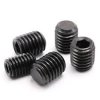andrew_donaldson1
New Member
Hi experts!
Long story short, exhaust stud stuck in engine and drilling out process went a bit off and now a small amount of coolant is leaking out of the freshly drilled hole.
1st question: Im assuming the head now needs replacing?
2nd question: can the head be removed and a new one replaced with engine still in the frame?
Or, is it easier to remove the whole engine and do it on the bench?
2015 S10 for reference.
Thanks in advance everyone
Andy
Long story short, exhaust stud stuck in engine and drilling out process went a bit off and now a small amount of coolant is leaking out of the freshly drilled hole.
1st question: Im assuming the head now needs replacing?
2nd question: can the head be removed and a new one replaced with engine still in the frame?
Or, is it easier to remove the whole engine and do it on the bench?
2015 S10 for reference.
Thanks in advance everyone
Andy

